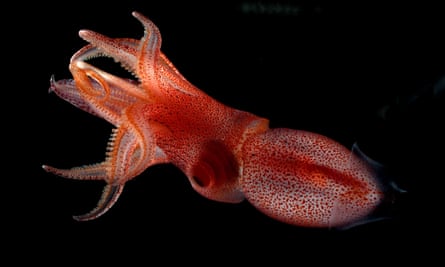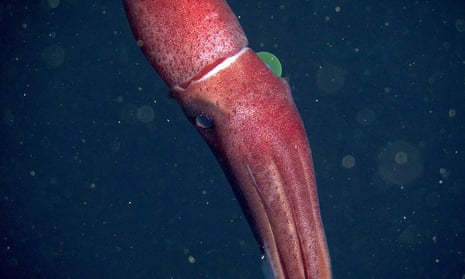Cockeye squid face a conundrum. Living hundreds of metres underwater, they float in between two worlds. Above them is the surface ocean, where a dim blue fraction of sunlight filters down. Below them is the deep sea, sunless and black. Which way to look?
Their mismatched eyes solve the problem – by letting them gaze into both worlds at once.
The squid are born with two identical eyes, but the left eyeball grows much faster, eventually forming a long tube, often with a bright yellow lens. This huge, highly sensitive eye gazes upwards and looks for the dark silhouettes of food or enemies passing overhead. The yellow colour filters out background light and breaks the camouflage of glowing animals that try to blend with the blue around them.
Q&AWhat is the Discovered in the deep series?
Show
The ocean is one of the world’s last truly wild spaces. It teems with fascinating species that sometimes seems to border on the absurd, from fish that look up through transparent heads to golden snails with iron armour. We know more about deep space than deep oceans, and science is only beginning to scratch the surface of the rich variety of life in the depths.
As mining companies push to industrialise the sea floor and global leaders continue to squabble over how to protect the high seas, the Guardian's Seascape series, Discovered in the deep, will profile some of the most recently discovered weird, wonderful, majestic, ridiculous, hardcore and mind-blowing creatures. They reveal how much there is still to learn about the least known environment on Earth – and how much there is to protect.
The right eyeball, meanwhile, ends up less than half the diameter of its partner. The squid aims it downwards, scanning for flashes of glowing animals against the dark waters below.
“It’s a lovely example of how they exploit and inhabit those two very different environments,” says Jon Ablett, senior curator of molluscs at the Natural History Museum in London.
Although cockeye squid (Histioteuthis heteropsis) have been known to science for decades, scientists recently caught one on an expedition around the remote Atlantic islands of Ascension and Saint Helena which brilliantly lived up to another name for the creature – the jewel squid. With an ultraviolet torch shining on it, the squid’s finger-length body twinkled all over in ruby red spots.
“When you get within about 15cm suddenly everything glows red, and the closer you go, the stronger the colour is,” says James Maclaine, senior curator of fish at the Natural History Museum, who brought a UV torch on the expedition to see which animals perform this trick. “It’s really dramatic,” he says.
As far as he knows, no other scientists have tried shining UV light on deep-sea animals. Maclaine found that some have red-glowing spots, including jewel squid and viperfish, and some, such as lanternfish, don’t.

The red dots are light-emitting organs, known as photophores, which actually glow blue when the squid are swimming hundreds of metres underwater. There is no UV light in the deep sea so the photophores don’t glow red in their natural environment.
Like the animals they’re trying to spot with their big yellow eye, cockeye squid may use their glowing photophores to disguise their silhouette. Flashing bioluminescent lights could also be a form of squid communication and a way to attract mates. Or they could lure in prey that mistake them for something to eat. “It’s possibly all of these reasons,” says Ablett, “a little bit of camouflage, a little bit of sexual selection, a little bit of attracting prey.”
